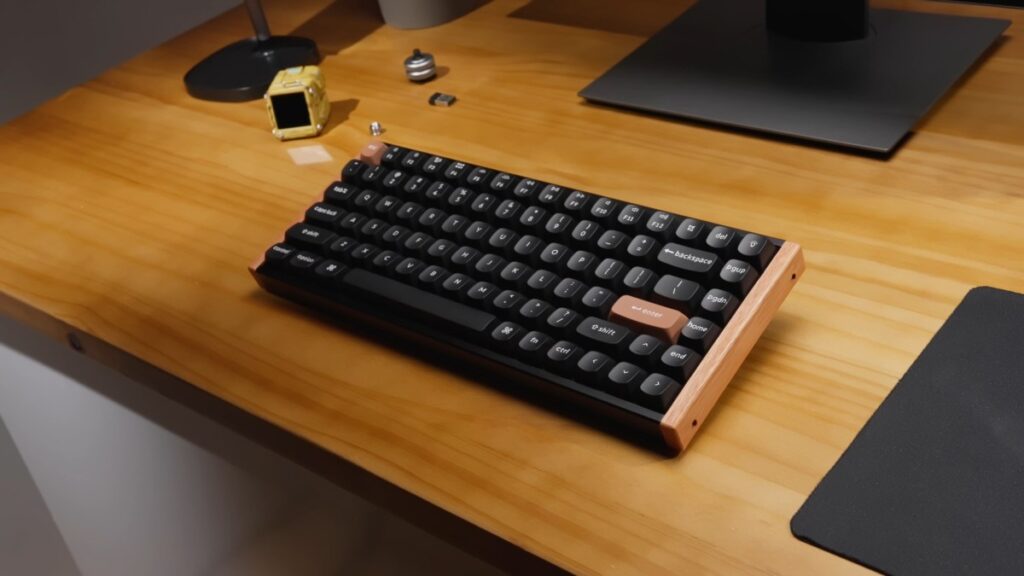The $79 K2 has long been one of Keychron’s most popular mechanical keyboards. Known for its straightforward, no-frills design, the K2 offers all the benefits of a mechanical keyboard at an affordable price point. Featuring a 75% layout (with arrow keys and function keys, but no numpad), it’s been a fan favorite for users seeking a compact yet functional keyboard.
However, Keychron is now stepping up its game with the release of the wireless K2 HE model, featuring Gateron double-rail magnetic switches and an upgraded chassis option that combines wood, aluminum, and plastic. Starting at $130 (or $125 during its Kickstarter campaign), this new version adds a touch of luxury while maintaining the accessible price range that Keychron is known for. For those who are particularly drawn to the added gaming features of magnetic switches, the extra $10 for the special edition with wooden side panels may be worth it.
Like many of Keychron’s new products, this K2 HE launch is being funded via Kickstarter. While crowdfunding typically comes with risks, for Keychron, this is more of a pre-sale event, with the first units scheduled to ship in October.
Design and Build Quality
The main choice for potential buyers is whether to opt for the standard version with an aluminum frame and plastic body or to splurge on the special edition with wood accents. The dark rosewood on the black special edition gives off a vintage synthesizer vibe, while the lighter wood option offers a minimalist aesthetic.
Keychron’s K2 HE isn’t the only keyboard with wood accents, but few mainstream brands offer a design that mixes wood with aluminum and plastic in such a polished way. The blend of materials gives the K2 HE a premium look without sacrificing durability. Despite being a relatively affordable keyboard, the combination of aluminum and wood accents makes the board feel solid and not “cheap” — an impressive feat at this price point.
The sound profile of the keyboard is another standout. While it’s slightly muted, the keyboard produces a pleasant “thocky” sound, which some users may find more satisfying than the higher-pitched or “poppy” tones of other mechanical keyboards. The use of a silicone pad and acoustic foam helps eliminate the notorious “board ping,” ensuring a quieter, more refined typing experience.
Switches and Performance
A major upgrade with the K2 HE is the introduction of Gateron’s pre-lubed magnetic switches. This is Keychron’s first time incorporating magnetic switches into their keyboards, and they perform remarkably well. The magnetic mechanism allows for faster key presses and resets, making it ideal for gaming where rapid key actions are necessary.
What truly sets the K2 HE apart is the precision control it offers over the actuation distance. Users can adjust the keypress distance from 0.2mm to 3.8mm in 0.1mm increments. This allows for extremely sensitive typing, preventing accidental keystrokes and providing a more customized experience. In gaming scenarios, the magnetic switches offer “speed triggers” that reset much faster than traditional switches, allowing users to execute rapid actions, which is perfect for fast-paced gaming like first-person shooters.
Magnetic switches also offer greater flexibility in terms of functionality. Keychron has included the ability to set up macros that trigger different actions at varying points during the key press and release, with up to four actions available per keystroke. This feature can enhance both gaming and productivity, allowing users to program actions like switching between walking and running with a single key press.
Typing Experience and Comfort
Though the K2 HE is an upgrade from the standard K2, it does come with some trade-offs. One of the compromises is the lack of flex in the chassis, which might make long typing sessions feel a bit more fatiguing for some users. While this is likely a consideration for gamers who prioritize precision and customizability, typing enthusiasts may feel the lack of flex over prolonged periods.
For keycap enthusiasts, Keychron sticks with standard Cherry profile keycaps in the K2 HE, which is a welcome change from the higher KSA keycaps found in previous Keychron models. During testing, the OEM profile caps were swapped out for Keychron’s Cherry keycaps, and the result was an improved typing experience.
In terms of adjustability, the K2 HE offers two small plastic feet that allow users to change the keyboard’s typing angle, a feature that’s often overlooked in many modern mechanical keyboards. This simple but useful addition enhances comfort for users who type for extended periods.
Features and Customization
The K2 HE offers 22 different lighting effects with LEDs under each key, making it a great choice for those who enjoy customizable lighting. Whether you prefer a subtle backlight or a vibrant RGB display, the K2 HE has you covered.
However, there are some limitations to consider. Unlike some boards that support both magnetic and traditional switches, the K2 HE’s PCB is designed specifically for magnetic switches. This might be a dealbreaker for users who prefer the option to switch between different types of switches. Additionally, there’s no knob for volume control, which is available on some other Keychron models.
Conclusion
The Keychron K2 HE is an impressive step up from its predecessor, offering magnetic switches, a premium design, and excellent customization options at a still-affordable price point. It’s a solid choice for gamers looking for a keyboard that combines gaming features with a more sophisticated look. The K2 HE’s magnetic switches, in particular, offer notable advantages in gaming, providing faster keystrokes and increased customization.
If you’re looking for a budget-friendly entry into magnetic switch technology or want a keyboard that balances functionality and style, the K2 HE is an excellent option. The Kickstarter pre-sale may be the best way to secure one at a lower price, and with shipping set for October, it’s just around the corner.


















